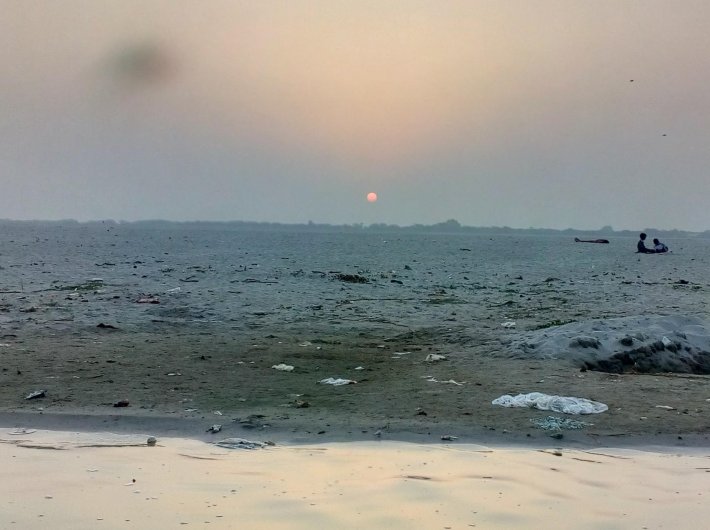A new study titled, ‘Quantitative analysis of Microplastics along River Ganga’ by Toxics Link has found heavy concentration of microplastics in the Ganga.
All samples collected for study from the river at Haridwar, Kanpur and Varanasi were found to be polluted with microplastics. The river waters were found to be polluted with multiple types of plastic. Highest concentration of single-use and secondary plastic products was found at Varanasi.
Microplastics are defined as plastics less than 5 mm in length and recognized as a major source of marine pollution of significant concern due to their persistence, ubiquity and toxic potential.
Microplastic pollution in the Ganga can have many ramifications as Ganga water is used for various purposes which can lead to severe impacts on the environment as well as human health. The river is the major source of drinking water for cities situated along its banks and microplastics pollution is a cause of concern.
Untreated sewage from many cities along the river’s course, industrial waste and religious offerings wrapped in non-degradable plastics add large amounts of pollutants to the river as it flows through many cities that are densely populated. Plastic products and waste materials released or dumped in the river break down and eventually get reduced to micro particles and flows downstream into the ocean which is the ultimate sink of all plastics being used by humans.
The river water testing was carried out in collaboration with the National Institute of Oceanography, Goa. A set of five water samples were collected from the river bank at Haridwar, Kanpur and Varanasi. The samples were tested through FTIR to identify the exact type or resin core.
The study found presence of significantly high (40) different kinds of polymers as microplastics in Ganga waters. Resins like EVOH, Polyacetylene, PIP, PVC and PVAL were predominant in all three locations. The shapes and nature of the observed resins ranged from fibres to fragments, films and beads and fragments were the predominant shape in all locations followed by film and fibre.
Among the three cities, Varanasi showed the maximum load of microplastics in the Ganga waters as compared to the other two cities. The results indicate greater microplastic pollution in the downstream river from Haridwar to Varanasi. Microbeads were seen in Varanasi and Kanpur, while no beads were found in Haridwar.
“We found that Haridwar samples had the lowest number of MPs/m3 (1.30±0.518) as compared to other two locations Varanasi and Kanpur. The most frequent size range observed in all the samples was less than 300um,” said Dr Mahua Saha, lead researcher, NIO
There are reports that also suggest that MPs can pass through the filtration systems and finally land up in our body. Discarded plastic waste contributes to marine pollution with devastating consequences for marine life and the habitats they depend on.
The study says that though currently there is inadequate information on impact of microplastics on health it is important to know and be mindful of the fact that plastics are laced with multiple types of additives and chemicals that are known toxins which could be leaching into the water.
There are reports that also suggest that MPs can pass through the filtration systems and finally land up in our body. Discarded plastic waste adds to marine pollution with devastating consequences for marine life and the habitats they depend on and affects the food web due to uptake of MPs by marine organisms. More than 663 species are affected adversely due to marine debris and 11% of them are said to be related to microplastic ingestion alone. These microplastics being drained from the river system into oceans can cause serious imbalance in the marine-ecosystem and food web.
It further says that though Plastic Waste Management Rules have been in force in the country their implementation remains poor. It calls for improving implementation of the plastic rules, along with strict enforcement of ban on single-use plastics. It also calls for more data and research on microplastics and their impacts on our river systems.
“We need to address the threat of plastic on aquatic life more realistically and with a futuristic eye. Various stakeholders, including the industry, government, civil society organisations need to join hands for improving plastic waste management and the subsequent reduction in microplastic pollution,” Satish Sinha, associate director, Toxics Link said.
Key Findings
(1) The Ganga was found to be polluted with plastic waste mainly single- use and secondary plastic products
(2) Number of MPs detected in the surface water of river Ganga in Varanasi was (2.42±0.405 MPs/m3)
(3) Number of MPs detected in surface water of river Ganga in Kanpur was (2.16±0.500 MPs/m3)
(4) Haridwar had the lowest number of MPs/m3 (1.30±0.518) as compared to Varanasi and Kanpur
(5) Fragments were the predominant shape in all locations followed by film and fibre. Slight difference was observed in Kanpur as fibres were more abundant than films
(6) Most frequent size range observed in all the samples was less than 300u m
(7) Black and brown coloured particles were found to be more in number followed by coloured particles in all the three locations
(8) Dominance of black coloured particles suggests its origin from abrasion of tires
(9) Several types of rubbers (butadiene, polyisoprene, natural rubber) were abundantly found in the river
(10) 40 different types of polymers were found during analysis. EVOH, Polyacetylene, PIP, PVC and PVAL were predominantly found in all the three locations.

